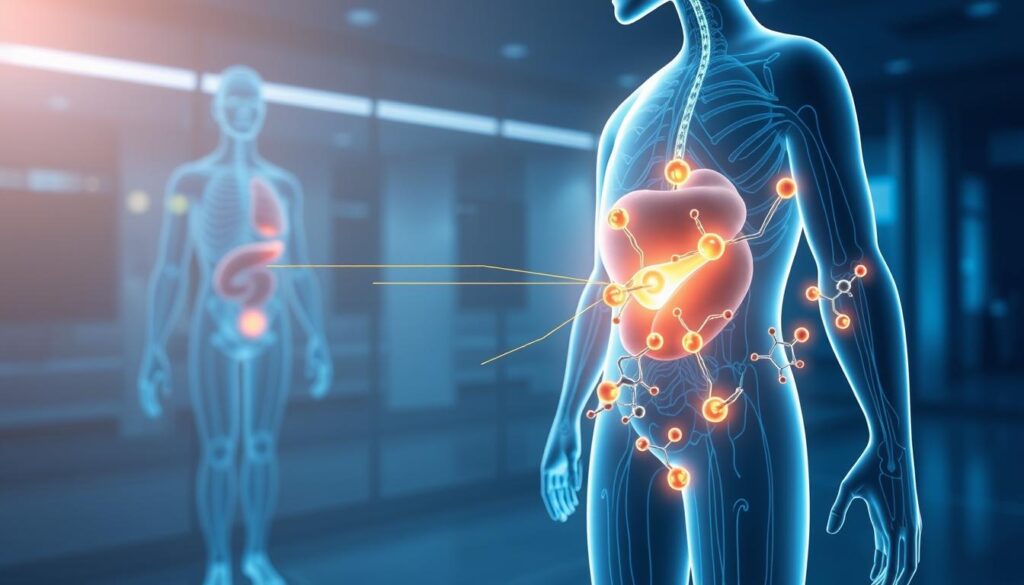GLP-1 receptor agonists have gained popularity for their effectiveness in managing type 2 diabetes and aiding in weight loss. However, concerns have been raised about their potential side effects, particularly fatigue. As the use of these medications continues to grow, it’s essential to understand the relationship between GLP-1 medications and the tiredness they may cause.
Many individuals taking GLP-1 receptor agonists have reported feeling tired or experiencing a lack of energy. This has sparked a crucial conversation about the potential impact of these medications on daily life. In this article, we’ll delve into the world of GLP-1 medications and explore the issue of fatigue associated with their use.
Key Takeaways
- GLP-1 receptor agonists are used for type 2 diabetes management and weight loss.
- Fatigue is a reported side effect of GLP-1 medications.
- Understanding the cause of fatigue is crucial for effective management.
- Lifestyle changes can help mitigate fatigue associated with GLP-1 medications.
- Consulting a healthcare professional is essential for addressing concerns about fatigue.
Understanding GLP-1 Receptor Agonists: A Comprehensive Overview
As a class of medications that mimic a natural hormone in the body, GLP-1 receptor agonists offer a promising approach to managing diabetes and obesity. These medications have gained significant attention in recent years due to their effectiveness in regulating blood sugar levels and appetite. Interested in micro dosing? Learn more about GLP-1 Products and how to get started at EllieMD.com
What Are GLP-1 Receptor Agonists?
GLP-1 receptor agonists are a type of medication that works by mimicking the action of the natural incretin hormone GLP-1 (Glucagon-Like Peptide-1). They help regulate blood sugar levels by enhancing insulin secretion, suppressing glucagon release, and slowing gastric emptying. This class of medications has been shown to be effective in improving glycemic control and promoting weight loss.

Approved Uses and Applications
GLP-1 receptor agonists are primarily approved for the treatment of type 2 diabetes. They are used to improve glycemic control and reduce the risk of major adverse cardiovascular events. Some GLP-1 receptor agonists are also approved for chronic weight management in adults with obesity.
Growing Popularity in Weight Management and Diabetes
The use of GLP-1 receptor agonists has gained popularity in both weight management and diabetes treatment due to their effectiveness in promoting weight loss and improving glycemic control. Their ability to reduce appetite and improve metabolic health has made them a valuable therapeutic option for patients with diabetes and obesity.
| Medication | Primary Use | Administration Frequency |
|---|---|---|
| Semaglutide (Ozempic) | Type 2 Diabetes | Once Weekly |
| Liraglutide (Saxenda) | Weight Management | Once Daily |
| Tirzepatide (Mounjaro) | Type 2 Diabetes | Once Weekly |
GLP-1 receptor agonists have become an essential part of the treatment regimen for many patients with diabetes and obesity. Their ability to improve glycemic control, promote weight loss, and reduce cardiovascular risk has made them a valuable therapeutic option.
The Science Behind GLP-1 Medications
Understanding the science behind GLP-1 receptor agonists is crucial for appreciating their benefits and potential side effects. GLP-1 medications work by mimicking the action of the naturally occurring hormone glucagon-like peptide-1, which plays a significant role in glucose metabolism and appetite regulation.
How GLP-1 Receptor Agonists Work in the Body
GLP-1 receptor agonists activate GLP-1 receptors in various parts of the body, including the pancreas, brain, and gastrointestinal tract. This activation triggers a cascade of effects that improve insulin secretion, slow gastric emptying, and reduce appetite.
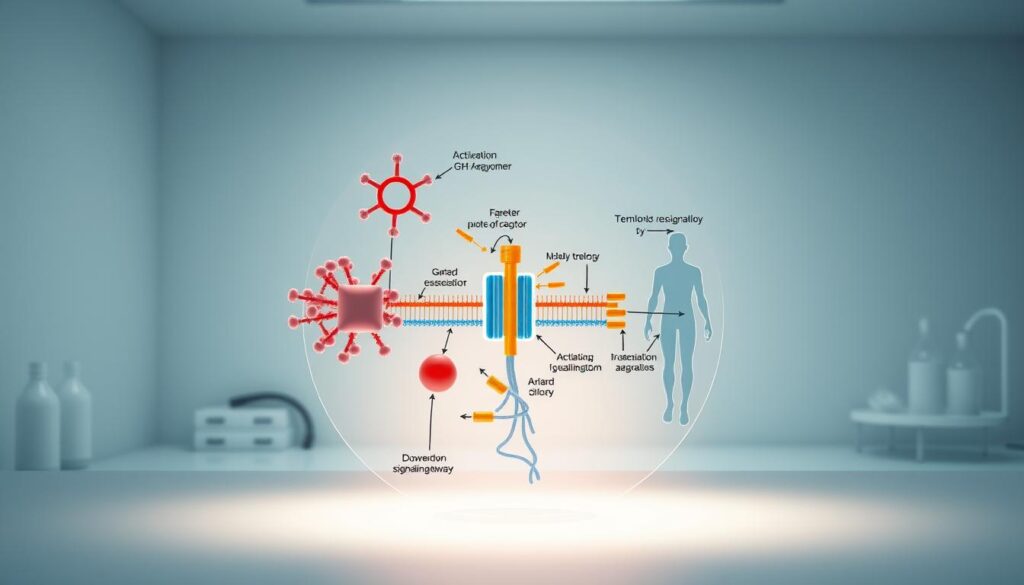
Impact on Blood Sugar Regulation
One of the primary effects of GLP-1 medications is their ability to enhance glucose-dependent insulin secretion. This means that they help the body release more insulin when blood glucose levels are high, thereby lowering blood sugar.
Effects on Appetite and Satiety
GLP-1 receptor agonists also influence appetite and satiety by slowing gastric emptying and promoting feelings of fullness. This can lead to reduced caloric intake, which is beneficial for weight management. However, these changes in appetite and digestion can sometimes contribute to side effects like nausea and potentially glp 1 therapy fatigue.
By understanding how GLP-1 medications work, patients and healthcare providers can better navigate the benefits and challenges associated with glp 1 drugs fatigue and other side effects, making informed decisions about their treatment plans.
Common Side Effects of GLP-1 Medications
While GLP-1 medications offer numerous benefits, they can also cause unwanted side effects in some users. These side effects can vary in severity and impact different people in different ways.
Gastrointestinal Side Effects
Gastrointestinal issues are among the most commonly reported side effects of GLP-1 receptor agonists. These can include:
- Nausea and vomiting
- Diarrhea
- Abdominal pain
- Constipation
These symptoms can be uncomfortable and, in some cases, may lead to dehydration or electrolyte imbalances if not properly managed.
Injection Site Reactions
As GLP-1 medications are administered via injection, some users may experience reactions at the injection site. These can include:
- Redness or swelling
- Itching or rash
- Pain or discomfort
Most injection site reactions are mild and temporary, but in some cases, they can be more severe.
Other Reported Side Effects
In addition to gastrointestinal issues and injection site reactions, other side effects have been reported by users of GLP-1 medications. These can include:
- Headache
- Dizziness
- Fatigue
- Increased risk of pancreatitis

It’s essential for patients to discuss any side effects with their healthcare provider to determine the best course of action. In some cases, adjusting the dosage or switching to a different medication can help mitigate these effects.
Understanding the potential side effects of GLP-1 medications is crucial for making informed decisions about treatment. By being aware of these possible effects, patients can better manage their condition and improve their overall quality of life.
GLP 1 Fatigue: Understanding the Connection
Understanding the relationship between GLP-1 medications and fatigue is essential for optimizing treatment outcomes. GLP-1 receptor agonists have revolutionized the management of type 2 diabetes and obesity, but like any medication, they come with potential side effects. One of the reported side effects is fatigue, a condition characterized by persistent tiredness or lack of energy.

Prevalence of Fatigue Among GLP 1 Users
Fatigue is a common complaint among individuals using GLP-1 receptor agonists. Studies have shown that a significant percentage of users experience fatigue, although the exact prevalence can vary depending on the specific medication and study population.
Clinical trials and real-world studies have provided valuable insights into the prevalence of fatigue among GLP-1 users. For instance, a study on semaglutide reported fatigue in a notable proportion of participants.
Clinical Studies on GLP 1 and Energy Levels
Clinical studies have investigated the impact of GLP-1 receptor agonists on energy levels. Research has shown that these medications can affect metabolic processes, potentially influencing energy levels. Some studies have suggested that the fatigue associated with GLP-1 receptor agonists may be related to factors such as dehydration, nutritional deficiencies, or metabolic changes.
A comprehensive review of clinical trials revealed that while fatigue is a reported side effect, its severity and frequency vary across different GLP-1 medications and patient populations.
Patient Experiences with GLP 1-Related Fatigue
Patient experiences with GLP 1-related fatigue can provide valuable insights into the real-world impact of this side effect. Many patients report varying levels of fatigue, from mild tiredness to more severe forms that can affect daily activities.
Some patients have reported that their fatigue improved over time as their bodies adjusted to the medication, while others have found it necessary to make lifestyle adjustments to manage their energy levels.
The Mechanism Behind GLP 1 Fatigue
The phenomenon of GLP-1 fatigue is complex, involving multiple physiological changes that affect energy levels. GLP-1 receptor agonists alter various metabolic processes, which can contribute to feelings of fatigue.
Metabolic Changes and Energy Expenditure
GLP-1 medications influence metabolic rate and energy expenditure. By enhancing insulin secretion and suppressing glucagon release, these medications can lead to changes in energy metabolism. Some studies suggest that this shift may result in decreased energy levels.
As noted by a study published in a medical journal, “The metabolic adjustments induced by GLP-1 receptor agonists can have a profound impact on the body’s energy homeostasis.”
“The metabolic adjustments induced by GLP-1 receptor agonists can have a profound impact on the body’s energy homeostasis.”
Impact on Sleep Patterns
Sleep disturbances are another potential contributor to GLP-1 fatigue. Some patients report changes in sleep quality or duration after initiating GLP-1 therapy. Research indicates that GLP-1 receptor agonists may affect sleep regulation, although the exact mechanisms are not fully understood.
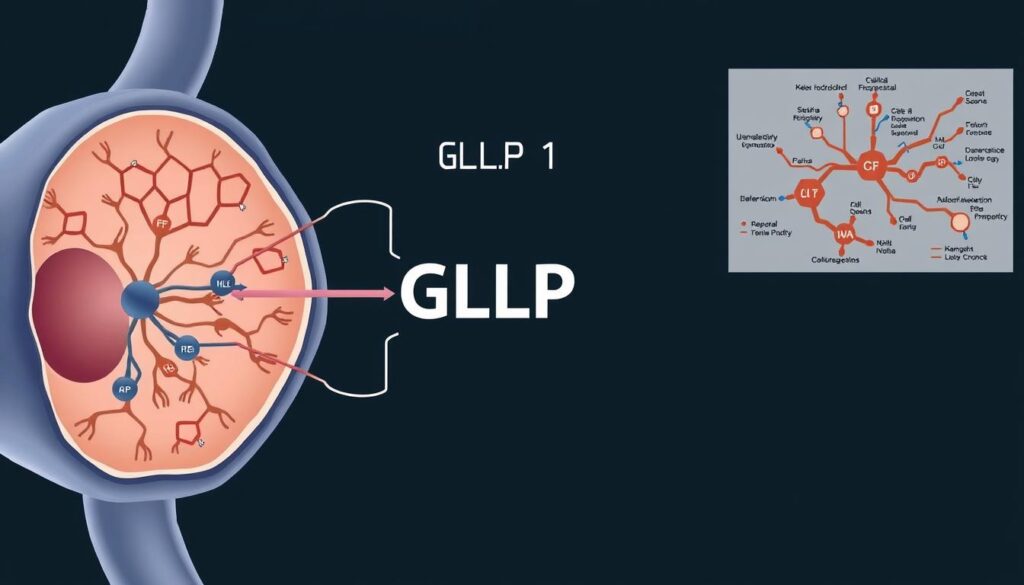
Nutritional Factors Contributing to Fatigue
Inadequate nutrition can exacerbate fatigue in individuals taking GLP-1 medications. These medications often lead to reduced appetite and altered eating patterns. If not managed properly, this can result in insufficient nutrient intake, contributing to feelings of fatigue.
| Nutritional Factor | Impact on Fatigue |
|---|---|
| Inadequate Protein Intake | Can lead to muscle weakness and fatigue |
| Reduced Caloric Intake | May result in energy deficits |
| Micronutrient Deficiencies | Can cause a range of symptoms including fatigue |
Understanding the mechanisms behind GLP-1 fatigue is crucial for developing effective management strategies. By addressing metabolic changes, sleep disturbances, and nutritional factors, healthcare providers can help mitigate this side effect and improve patient outcomes.
Review of Popular GLP 1 Medications and Their Fatigue Profiles
Recent studies have shed light on the varying effects of popular GLP-1 medications on fatigue, providing valuable insights for patients and clinicians. GLP-1 receptor agonists have become a cornerstone in the treatment of type 2 diabetes and obesity, but their impact on energy levels can differ significantly between medications. Learn more about GLP-1 Products and how to get started at EllieMD.com
Semaglutide (Ozempic, Wegovy)
Semaglutide, marketed as Ozempic for type 2 diabetes and Wegovy for weight management, has shown significant efficacy in both glycemic control and weight loss.
Overview and Effectiveness
Clinical trials have demonstrated that semaglutide can reduce HbA1c levels by up to 1.5% and promote weight loss of up to 15% of initial body weight. Its once-weekly dosing schedule has contributed to its popularity among patients.
Fatigue Incidence and Severity
Studies have reported varying rates of fatigue associated with semaglutide. In the SUSTAIN trials, fatigue was reported in 4-11% of patients receiving semaglutide, compared to 4-7% in the placebo group.
Pros and Cons
The advantages of semaglutide include its high efficacy in weight loss and glycemic control, as well as its convenient once-weekly administration. However, potential drawbacks include the risk of gastrointestinal side effects and the need for careful monitoring in patients with a history of pancreatitis.
Liraglutide (Saxenda, Victoza)
Liraglutide, sold under the brand names Victoza for type 2 diabetes and Saxenda for weight management, has been widely used since its approval.
Overview and Effectiveness
Liraglutide has been shown to reduce HbA1c levels by up to 1.2% and promote weight loss of up to 8% of initial body weight. Its daily dosing regimen is a key characteristic of this medication.
Fatigue Incidence and Severity
In clinical trials, fatigue was reported in 4-7% of patients receiving liraglutide, which is generally comparable to placebo rates. However, some patients may experience increased fatigue during the initial treatment phase.
Pros and Cons
Liraglutide’s strengths include its established safety profile and effectiveness in both diabetes management and weight loss. On the downside, its daily injection schedule may be less convenient for some patients compared to once-weekly alternatives.
Tirzepatide (Mounjaro)
Tirzepatide, marketed as Mounjaro, is a newer GLP-1 receptor agonist that also incorporates GIP receptor agonism, offering a dual mechanism of action.
Overview and Effectiveness
Clinical trials have shown that tirzepatide can reduce HbA1c levels by up to 2.0% and promote significant weight loss. Its once-weekly dosing is similar to semaglutide.
Fatigue Incidence and Severity
In the SURPASS trials, fatigue was reported in 6-14% of patients receiving tirzepatide, with higher doses associated with slightly increased rates of fatigue.
Pros and Cons
Tirzepatide’s advantages include its high efficacy in both glycemic control and weight loss, as well as its once-weekly dosing. Potential drawbacks include its relatively recent approval, which means long-term safety data is still being collected.
| Medication | Fatigue Incidence | Dosing Frequency | Weight Loss Efficacy |
|---|---|---|---|
| Semaglutide (Ozempic, Wegovy) | 4-11% | Once-weekly | Up to 15% |
| Liraglutide (Saxenda, Victoza) | 4-7% | Daily | Up to 8% |
| Tirzepatide (Mounjaro) | 6-14% | Once-weekly | Significant weight loss |
As shown in the table, each GLP-1 medication has its unique profile regarding fatigue incidence, dosing frequency, and weight loss efficacy. This information is crucial for healthcare providers and patients when selecting the most appropriate treatment option.
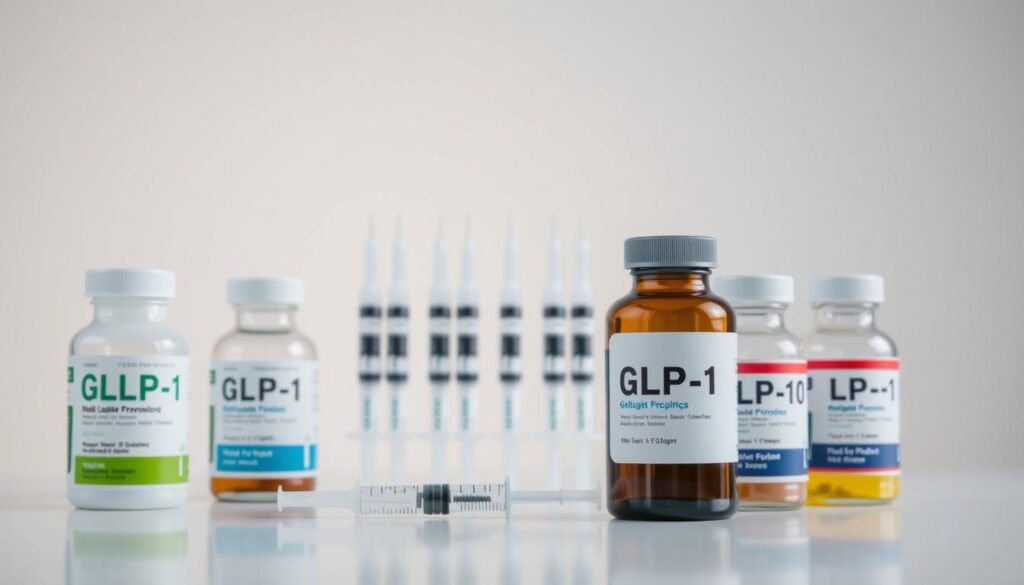
In conclusion, while all three GLP-1 medications are effective in managing type 2 diabetes and obesity, their impact on fatigue varies. Semaglutide and tirzepatide offer the convenience of once-weekly dosing, while liraglutide requires daily injections. The choice of medication should be tailored to individual patient needs and preferences, taking into account factors such as fatigue profile, efficacy, and dosing schedule.
Comparing Fatigue Levels Across Different GLP 1 Medications
Different GLP-1 medications exhibit distinct fatigue profiles, influenced by their formulation and dosage. Understanding these differences is crucial for patients and healthcare providers to make informed decisions about GLP-1 therapy.
Short-Acting vs. Long-Acting Formulations
GLP-1 receptor agonists can be categorized into short-acting and long-acting formulations based on their duration of action. Short-acting GLP-1 medications, such as exenatide, tend to have a more pronounced peak effect, which may influence the level of fatigue experienced by patients. In contrast, long-acting formulations like liraglutide and semaglutide provide a more steady-state activation of the GLP-1 receptor, potentially leading to different fatigue profiles.
A study comparing the effects of short-acting versus long-acting GLP-1 receptor agonists found that the incidence of fatigue varied between the two groups. The table below summarizes the findings:
| GLP-1 Medication | Formulation Type | Fatigue Incidence (%) |
|---|---|---|
| Exenatide | Short-acting | 15 |
| Liraglutide | Long-acting | 10 |
| Semaglutide | Long-acting | 12 |
Dosage Considerations and Fatigue
The dosage of GLP-1 medications is another critical factor that can influence fatigue levels. Higher doses are often associated with increased incidence of side effects, including fatigue. For instance, a clinical trial noted that patients on higher doses of semaglutide reported more fatigue compared to those on lower doses.
“The incidence of fatigue was higher in patients treated with semaglutide 1.0 mg compared to those treated with semaglutide 0.5 mg.”
Individual Variability in Response
It’s essential to recognize that individual responses to GLP-1 medications can vary significantly. Factors such as genetic predisposition, comorbid conditions, and concomitant medications can all impact how a patient experiences fatigue on GLP-1 therapy.
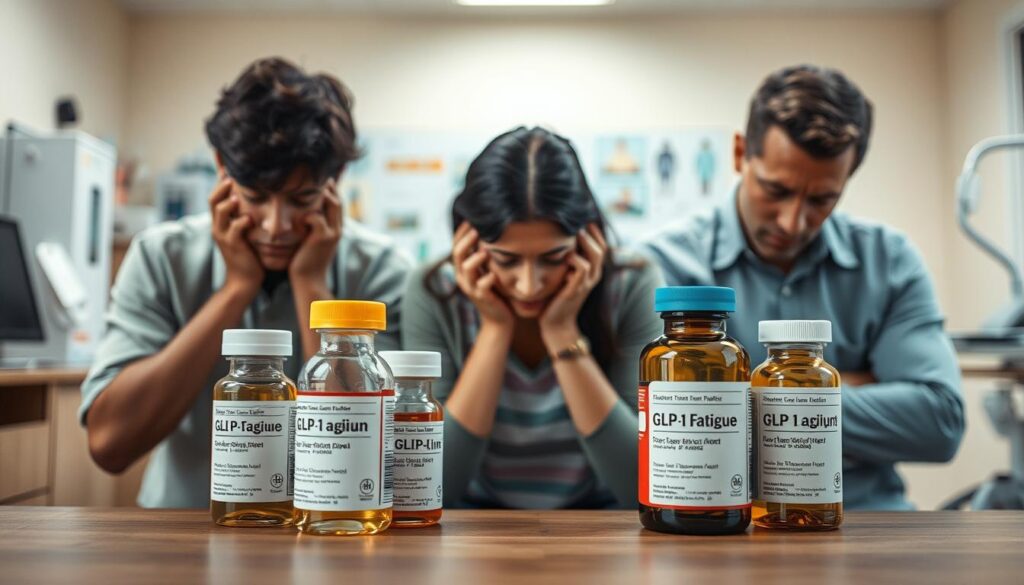
Effective glp 1 fatigue management requires a personalized approach, taking into account the specific GLP-1 medication, dosage, and individual patient factors.
Managing GLP 1 Fatigue: Practical Strategies
For individuals experiencing GLP-1 fatigue, implementing practical lifestyle changes can significantly improve energy levels. Managing GLP-1 fatigue requires a comprehensive approach that addresses various aspects of daily life.
Dietary Adjustments to Combat Fatigue
Diet plays a crucial role in managing GLP-1 fatigue. Increasing protein intake can help stabilize energy levels. It’s also beneficial to eat smaller, more frequent meals to avoid digestive discomfort that might exacerbate fatigue.
- Incorporate iron-rich foods to prevent anemia
- Consume complex carbohydrates for sustained energy
- Avoid high-sugar foods that can lead to energy crashes
Exercise and Physical Activity Recommendations
Regular physical activity is essential for improving energy levels. Start with low-intensity exercises like walking or yoga, and gradually increase the intensity as your body adapts.
- Begin with short exercise sessions and gradually increase duration
- Incorporate strength training to improve overall muscle mass
- Choose activities that you enjoy to maintain consistency

Sleep Optimization Techniques
Adequate sleep is vital for managing fatigue. Establish a consistent sleep schedule and create a bedtime routine to improve sleep quality.
- Avoid screens before bedtime
- Create a sleep-conducive environment
- Limit caffeine intake, especially in the afternoon
Hydration and Electrolyte Balance
Proper hydration is crucial for maintaining energy levels. Drink plenty of water throughout the day and consider incorporating electrolyte-rich beverages or supplements, especially if you’re experiencing excessive sweating or gastrointestinal side effects.
- Monitor your urine output to ensure you’re staying hydrated
- Include electrolyte-rich foods in your diet
- Be mindful of your body’s signs of dehydration
By implementing these practical strategies, individuals can better manage GLP-1 fatigue and improve their overall quality of life.
Medical Approaches to Addressing GLP 1 Fatigue
Addressing GLP-1 fatigue medically involves a combination of dosage adjustments and supplementary measures. Healthcare providers can employ several strategies to help mitigate this side effect.
Dosage Adjustments and Titration Schedules
One of the primary medical approaches to managing GLP-1 fatigue involves adjusting the dosage of the medication. Titration schedules can be modified to gradually increase the dose, allowing the body to adapt and potentially reducing the severity of fatigue.
A study on semaglutide, a popular GLP-1 receptor agonist, found that gradual titration significantly reduced the incidence of fatigue among participants.
Medication Timing Strategies
The timing of GLP-1 medication can also impact fatigue levels. Taking the medication at the right time of day can help minimize its energizing or de-energizing effects. For some patients, taking GLP-1 medications in the morning may be beneficial, while others might find it more effective to take it in the evening.
Supplementation Options
Certain supplements may help alleviate GLP-1 fatigue. Vitamin B12 and iron supplements are often recommended to address potential deficiencies that could exacerbate fatigue. However, it’s crucial to consult with a healthcare provider before adding any supplements to your regimen.
| Supplementation | Potential Benefits | Precautions |
|---|---|---|
| Vitamin B12 | Energy boost, reduction in fatigue | Consult before taking, potential interactions |
| Iron | Address iron deficiency, reduce fatigue | Risk of overdose, gastrointestinal side effects |
When to Consult Your Healthcare Provider
If GLP-1 fatigue persists or significantly impacts daily life, it’s essential to consult with a healthcare provider. They can assess the situation and recommend adjustments to the treatment plan, including alternative GLP-1 medications or additional therapies to manage fatigue.
Open communication with healthcare providers is key to effectively managing GLP-1 fatigue and ensuring that the benefits of GLP-1 therapy are not overshadowed by its side effects.
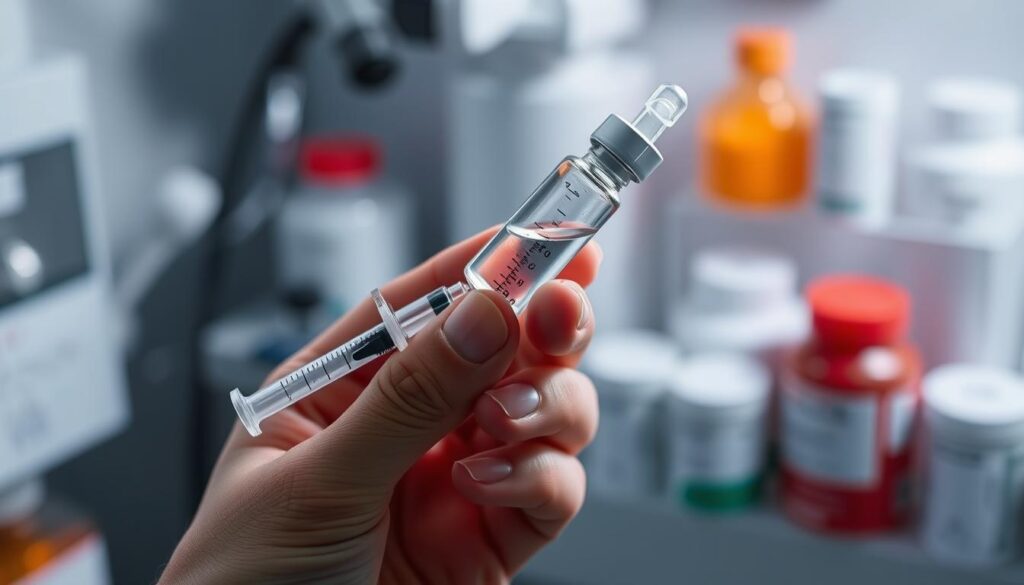
The Timeline of GLP 1 Fatigue: What to Expect
As individuals start GLP-1 receptor agonists, they often wonder how their energy levels will be affected over time. The experience of fatigue while on GLP-1 therapy can vary significantly as the body adjusts to the medication.
Initial Adjustment Period
During the initial stages of GLP-1 therapy, the body undergoes various adjustments. Some individuals may experience heightened fatigue due to the metabolic changes induced by the medication. For instance, a study mentioned in our GLP-1 fatigue FAQ highlights that the initial adjustment period is crucial for understanding how GLP-1 medications affect energy levels.
Long-Term Energy Level Patterns
As the body adapts, energy levels may stabilize or improve. Research indicates that long-term use of GLP-1 receptor agonists can lead to sustained improvements in metabolic health, potentially influencing fatigue positively.
Signs of Improvement and Adaptation
Signs that the body is adapting to GLP-1 therapy include gradual improvements in energy levels and overall well-being. Monitoring these changes is essential for managing GLP-1 fatigue effectively.
| Period | Common Experiences |
|---|---|
| Initial Adjustment | Increased fatigue, gastrointestinal adjustments |
| Long-term | Stabilization or improvement in energy levels |
Weighing the Benefits Against Fatigue: A Decision Framework
The decision to start GLP-1 therapy involves balancing its advantages with the potential for fatigue. GLP-1 receptor agonists have been shown to offer significant health benefits, particularly for individuals managing diabetes and obesity.
Health Benefits of GLP 1 Therapy
GLP-1 therapy is known for its effectiveness in improving glycemic control and aiding in weight loss. These benefits can lead to a reduction in the risk of major adverse cardiovascular events and improve overall health outcomes.
- Improved glycemic control
- Weight loss
- Reduced risk of cardiovascular events
Quality of Life Considerations
When evaluating GLP-1 therapy, it’s essential to consider its impact on quality of life. While the therapy can lead to significant health improvements, the potential for fatigue must be weighed against these benefits.
| Benefits | Considerations |
|---|---|
| Improved glycemic control | Potential for gastrointestinal side effects |
| Weight loss | Risk of fatigue |
| Reduced cardiovascular risk | Injection site reactions |
Individual Risk-Benefit Assessment
Each individual’s response to GLP-1 therapy can vary. A healthcare provider can help assess the potential benefits and risks, including the likelihood of experiencing fatigue.
Key factors to consider:
- Medical history
- Current health status
- Lifestyle and preferences
By carefully evaluating these factors, individuals can make informed decisions about whether GLP-1 therapy is right for them.
Recommendations for Different User Groups
The impact of GLP-1 medications on energy levels varies significantly among different populations, necessitating group-specific recommendations. As the use of GLP-1 receptor agonists continues to grow, understanding these differences is crucial for optimizing therapy outcomes.
Diabetes Patients
For diabetes patients, managing GLP-1-related fatigue involves careful monitoring of blood glucose levels and adjusting medication as needed. Regular physical activity and a balanced diet can also help mitigate fatigue. It’s essential for diabetes patients to work closely with their healthcare providers to find the right balance.
Weight Management Patients
Individuals using GLP-1 medications for weight management may experience fatigue due to changes in dietary habits and metabolic adjustments. Nutritional counseling can be beneficial in managing these effects. Ensuring adequate protein intake and staying hydrated are key strategies for minimizing fatigue.
Elderly Patients
Elderly patients may be more susceptible to GLP-1-related fatigue due to decreased physiological reserves and potential comorbidities. Regular monitoring of their condition and adjusting dosages or medication timing can help manage fatigue. Healthcare providers should consider the overall health status and other medications when prescribing GLP-1 therapies to elderly patients.
Physically Active Individuals
For physically active individuals, GLP-1-related fatigue might impact exercise performance and overall activity levels. Adjusting the timing of GLP-1 medication in relation to exercise can help minimize this effect. Additionally, ensuring adequate hydration and electrolyte balance is crucial for maintaining energy levels during physical activity.
| Patient Group | Key Recommendations |
|---|---|
| Diabetes Patients | Monitor blood glucose, adjust medication, regular physical activity, balanced diet |
| Weight Management Patients | Nutritional counseling, adequate protein intake, stay hydrated |
| Elderly Patients | Regular monitoring, adjust dosages or medication timing, consider overall health status |
| Physically Active Individuals | Adjust medication timing around exercise, ensure hydration and electrolyte balance |
By tailoring management strategies to the specific needs of different user groups, healthcare providers can help mitigate GLP-1-related fatigue and enhance the overall effectiveness of GLP-1 therapy.
“The key to managing GLP-1-related fatigue lies in understanding the unique needs of each patient group and adapting treatment strategies accordingly.”
Future Developments in GLP 1 Medications and Fatigue Management
Future developments in GLP-1 medications are poised to revolutionize the management of fatigue associated with these treatments. As the medical community continues to explore the potential of GLP-1 receptor agonists, ongoing research aims to develop new formulations with reduced side effects, including fatigue.
Emerging GLP 1 Formulations
Researchers are working on novel GLP-1 formulations that may offer better tolerability and reduced incidence of fatigue. These emerging formulations are designed to provide the therapeutic benefits of GLP-1 therapy while minimizing its drawbacks.
Research on Reducing Side Effects
Studies are focusing on understanding the mechanisms behind GLP-1 related fatigue, paving the way for strategies to mitigate this side effect. By investigating the metabolic changes and other factors contributing to fatigue, scientists can develop targeted approaches to reduce its occurrence.
Novel Approaches to Energy Management
In addition to advancements in GLP-1 medications, novel approaches to energy management are being explored. These include dietary adjustments, exercise regimens, and other lifestyle modifications that can help individuals manage fatigue while undergoing GLP-1 therapy.
As the field continues to evolve, patients can expect more effective and tolerable treatments for managing their conditions with GLP-1 medications.
Conclusion: Making Informed Decisions About GLP 1 Therapy
GLP-1 receptor agonists have revolutionized the treatment of diabetes and weight management, offering numerous benefits. However, potential side effects like glp 1 fatigue can impact quality of life. Understanding the connection between GLP-1 therapy and fatigue is crucial for making informed decisions.
By recognizing the causes of glp 1 receptor agonists fatigue and implementing strategies to manage it, individuals can maximize the benefits of their treatment. This may involve dietary adjustments, exercise, and sleep optimization, as well as discussing dosage adjustments or supplementation with healthcare providers.
Ultimately, the decision to start or continue GLP-1 therapy should be based on a thorough assessment of its benefits and potential side effects. By staying informed and working closely with healthcare professionals, individuals can make the most of GLP-1 therapy while minimizing its impact on energy levels. Learn more about GLP-1 Products and how to get started at EllieMD.com


